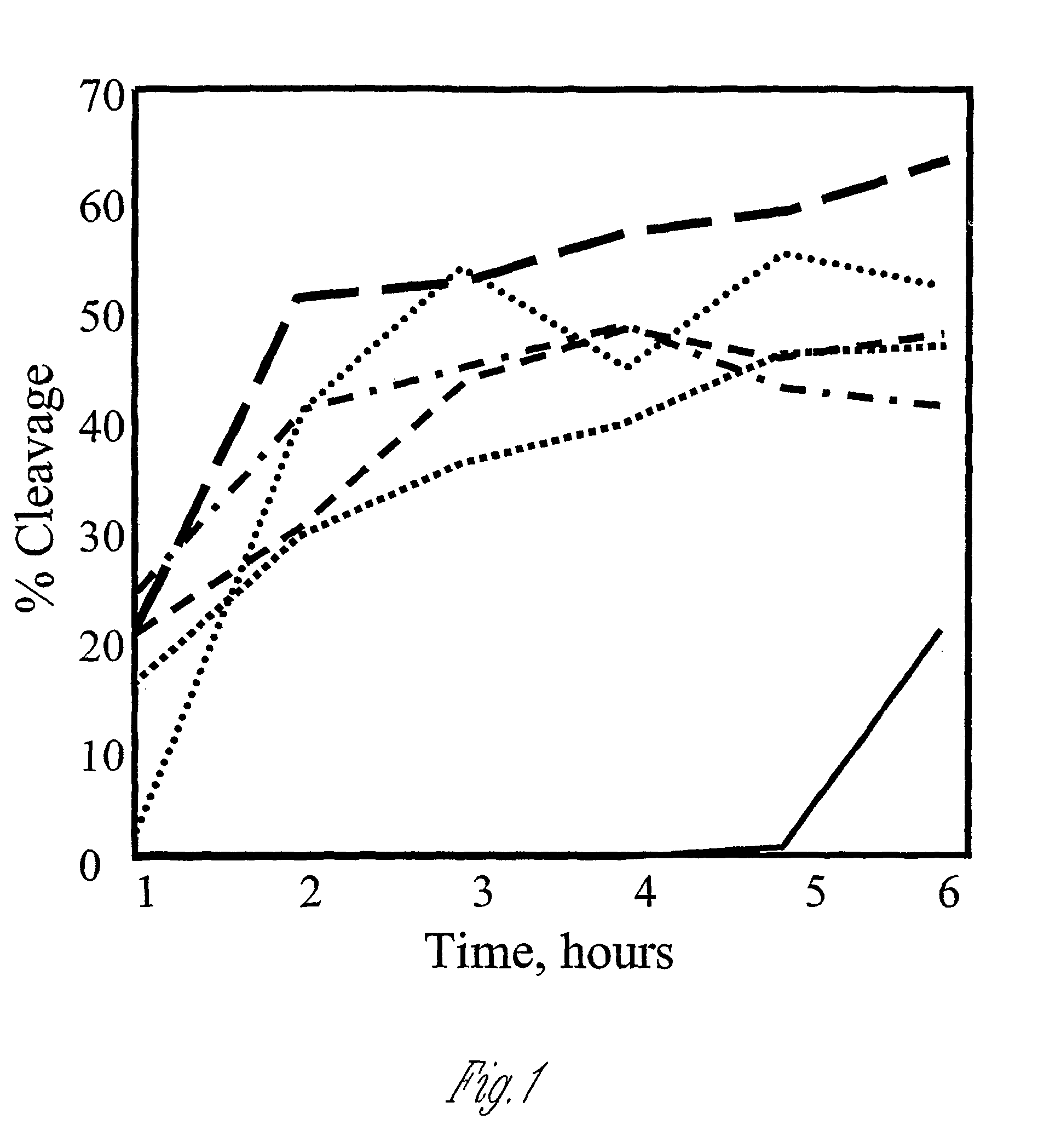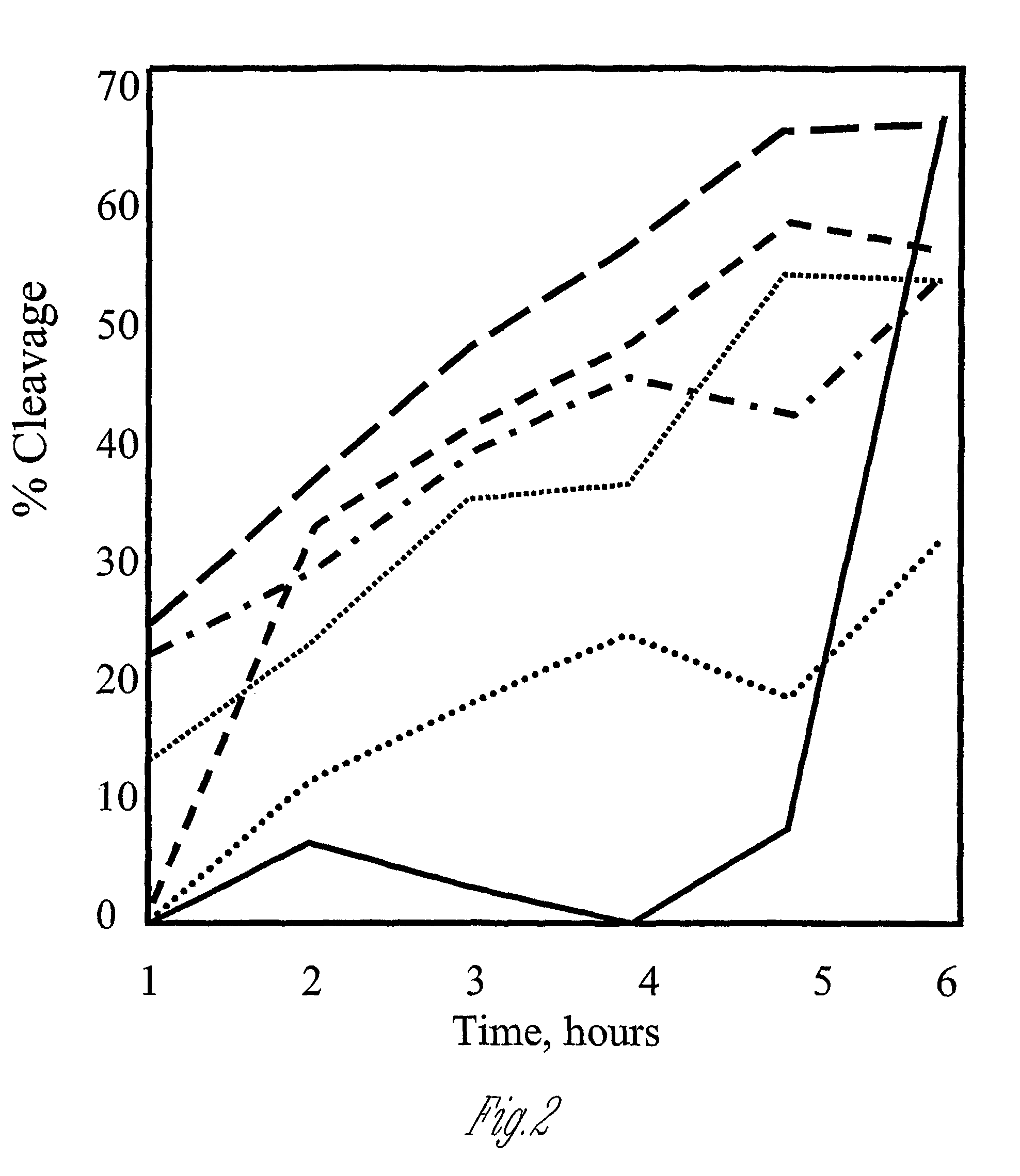Polypeptide cleavage process
a polypeptide and cleavage technology, applied in the field of polypeptide cleavage process, can solve the problems of partial or complete loss of peptide, inconvenient method, and inconvenient techniqu
- Summary
- Abstract
- Description
- Claims
- Application Information
AI Technical Summary
Benefits of technology
Problems solved by technology
Method used
Image
Examples
example 1
Expression of the T7tag-Vg-D4K-CH-GRF(1-44-CH (SEQ ID NO:1) Precursor Peptide
[0055]T7tag-Vg-D4K-CH-GRF(1-44)-CH (SEQ ID NO:1) was recombinantly expressed in E. Coli as follows. E. Coli bacteria containing the expression plasmid encoding the leader-CH-GRF(1-44)CH (SEQ ID NO:23) polypeptide (FIG. 7) were grown in 500 mL shake flasks containing tryptone, yeast, glucose, batch salts (sodium and potassium mono- and diphosphate salts and ammonium sulfate), and antibiotic. Inoculated shake flasks were subject to orbital shaking (200 rpm, 37° C.). Incubation was completed when the culture reached an optical density (OD) of 0.8-1.8 at 540 nm.
[0056]Fermenters ranging from 5 L to 100 L production capacities were seeded using shake flask cultures. The media included batch salts, glucose, and chelated metals solution (potassium citrate, sodium citrate, magnesium sulfate, phosphoric acid ferric chloride, zinc chloride, cobalt chloride, sodium molybdate, manganese chloride, calcium chloride, and c...
example 2
Isolation of Inclusion Body T7tag-Vg-D4K-CH-GRF(1-44)-CH (SEQ ID NO:1) Precursor Peptide
[0058]Production fermenter cells were harvested from the fermentation broth by centrifugation. Cell pellets were pooled, resuspended in an appropriate volume (for example, 2 L lysis buffer for material from a 5 L fermentor) of lysis buffer (6 g Tris free base and 0.93 g EDTA in 993 g water), and lysed in a high-pressure homogenizer.
[0059]Cell solids and peptide precursor-containing inclusion bodies were pelleted by centrifugation, collected, and dissolved via homogenization in 1.5 M citric acid / 1.0 mM EDTA solution, at a pH of approximately 1.0 (for example, 1.5 L solution for material from a 5 L fermentor). The pH of this suspension was adjusted to 4.9 by slow addition of 10 M sodium hydroxide with continuous mixing, while maintaining the temperature at less than 15° C. The precipitate containing the GRF precursor peptide was collected by centrifugation and washed twice by resuspending in water ...
example 3
Preparation of Palladate Cleavage Promoters
[0060]The following chemical abbreviations are used herein: en=ethylenediamine; pic=picolyl amine (or 2-aminomethyl pyridine); aep=2(2-aminoethyl) pyridine; dien=diethylenetriamine.
[0061]Na2PdCl4 and K2PdCl4 were purchased from Aldrich Chemical Co. and Strem Chemical Co.
[0062]Solid samples of tetrachloropalladate were solubilized in an appropriate aqueous solvent to a concentration of about 250 mM. Aliquots were then diluted into reaction mixtures to the appropriate concentrations. The solvents were chosen to be the same as the acid solution of the reaction under investigation.
PUM
| Property | Measurement | Unit |
|---|---|---|
| temperature | aaaaa | aaaaa |
| reaction time | aaaaa | aaaaa |
| temperature | aaaaa | aaaaa |
Abstract
Description
Claims
Application Information
 Login to View More
Login to View More - R&D
- Intellectual Property
- Life Sciences
- Materials
- Tech Scout
- Unparalleled Data Quality
- Higher Quality Content
- 60% Fewer Hallucinations
Browse by: Latest US Patents, China's latest patents, Technical Efficacy Thesaurus, Application Domain, Technology Topic, Popular Technical Reports.
© 2025 PatSnap. All rights reserved.Legal|Privacy policy|Modern Slavery Act Transparency Statement|Sitemap|About US| Contact US: help@patsnap.com



